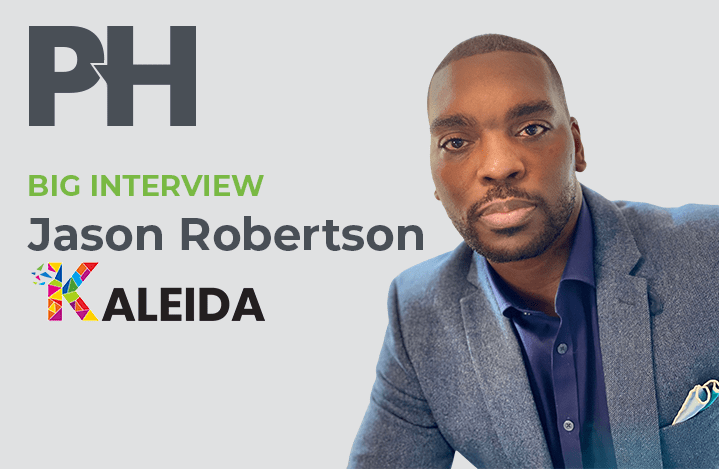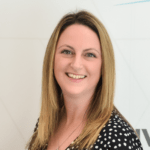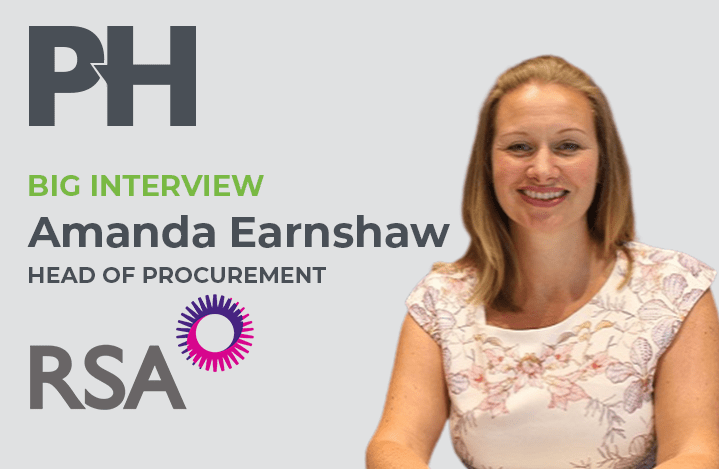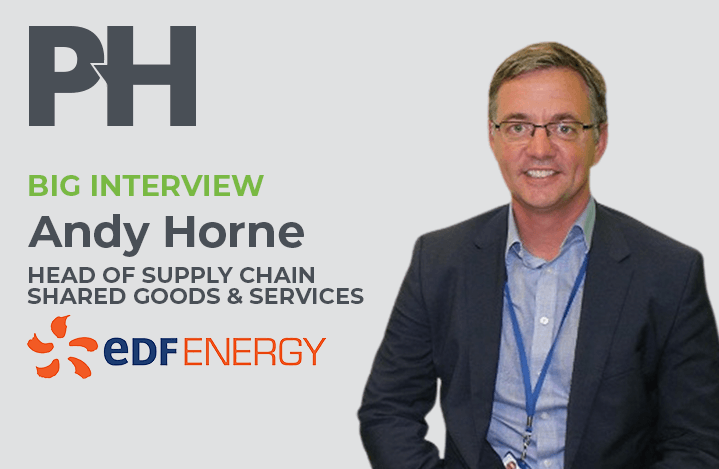Kaleida connects procurement to suppliers and diverse suppliers and for our latest Big Interview, Jason spoke with Procurement Heads‘ Operations Director Hayley Packham.
I didn’t go to university but started working in investment baking for about 11 years.
I spent five years at JP Morgan, and several other investment banks as well, and I then spent about 13 years selling technology back to banks, asset managers and hedge funds.
It was at that time that I came back with a couple of experiences that led me to feel there was a need for a platform like Kaleida.
It all revolved around prejudicial and stereotypical experiences that I had and trying to find a way to bridge the gap between buyers and suppliers.
For example, and I won’t say which company this was at, but one time I experienced a conversation with a colleague who was upset with what we were doing as a technology department, they got in my face and I walked away, when I went back to my desk my manager called me into his office and said: ‘Jason next time you go over to someone’s desk, bend down at it rather than stooping over them. Remember you’re a big guy, you’re a big black guy’.
Those words sat with me because I wasn’t aware of what he was doing, I understood his intention, he intended to say to me that sometimes people will see you differently than you see yourself.
I just see myself as J, but sometimes people put labels on you, or stereotypes on you, that end up becoming a weight or a burden.
Now I was, despite being from Brixton, a single parent Caribbean mother raised me and my brother and sister, race or colour or prejudice wasn’t part of the narrative that we had as a child growing up, so I went into this situation a bit naively not understanding how people would take me.
If I fast forward to when I was in sales as well often when I became self-aware of what people saw in me, this big 6’5” black male, intimidating Daily Mail headlines, it made me understand that when I went into a sales situation, those stereotypes sometimes preceded me, it basically meant there was an unconscious bias in the salesroom as well.
It is the same thing that women experience, disabled people experience, that the LGBTQ+ community experience that there is always this kind of stereotype, this bias, that you have to overcome to help them get some level of equality or equity in this day and age where people are quite quick to throw judgement.
For a number of years, I was actually the Head of Sales for these large US technology companies. Often, I would be running the office in the UK or working with a small team to launch a product in the UK market and often I would go into the sales room and a lot of them are white cis-gendered silver-haired males, but that was typically what the room felt like.
When I went into the room, I often had to try to make myself feel less threatening to what was the perception of how I was received, so I would start off with a comment like, ‘Oh it is nice to be out of the house and away from the wife and kids’, I tried to normalise that as a black man we are not just single-parent families, black men don’t leave their kids.
I tried to dispel these negative stereotypes to bring any hesitation in the room that might prevent me from doing my job well.
There is a saying that people buy from people, but also people buy from people who look like them and there is an understanding in this network and because I wasn’t like anyone in those executive rooms it felt alien and I had to try and normalise my normal.
We understand that if you are a female CEO, or if you are a disabled entrepreneur, or even if you are a veteran business owner when you walk into those rooms, particularly when the buying company hasn’t performed any level of EDI or E&I training for their staff, you have to overcome perceptions in order to normalise your presence in that room to be seen for the products or service you are selling.
There are a lot more barriers to overcome.
That is my background in why I built this fully inclusive platform.
Why the name Kaleida?
I wanted to build a feature and a platform that whenever you turn a dial just like a kaleidoscope when you turn it you will see the supply chain break out.
If you turn it one degree, you’ll see one degree of separation, then if you turn it again, you’ll see your suppliers’ suppliers and you can continue to see who your suppliers are and see where their suppliers are to see where if you do buy from an organisation where will your revenue that they earn make a difference.
Who is Kaleida aimed at and how is it functionally used?
If you look at supplier diversity in general today, what you find is the biggest threat to a successful supplier diversity challenge is that data is everywhere and what buyers actually want is one golden source of data to go to to find diverse suppliers.
So Kaleida is a fully inclusive B2B marketplace, it is aimed at those who work in sales, procurement, compliance and marketing.
If you look at other existing social media platforms today, they very much focus on the people element, but Kaleida means business, we are about connecting businesses together irrespective of the individuals involved.
If a corporate today wanted to spend money with diverse organisations they typically have to join many different non-governmental organisations or advocacy groups, that means if you make a massive commitment to spend a billion dollars we know that those cheques are going to cut a $50-$100,000 worth of product they will buy through that tender process, so what they need to do is send that one tender to these 10 different groups of minority and it just becomes too difficult, so what I wanted to do was build a fully inclusive platform.
We have a saying that is ‘exclusive is actually not inclusive’ if a corporate is supporting one ot two of those communities it excludes anyone who is not in those communities.
A diverse supplier is typically a company that is 51% owned by a diverse entity, but then if you try to roll these out in Singapore, South Africa or Poland, diversity becomes different because it is not about being black or Asian, something different becomes a minority, those are the challenges that these organisation face when trying to not positively discriminate and be seen through the lens of public society.
Anyone can join the platform and any Buyer can find anyone they want and then they hire based on the attributes and ability of the organisation, not the fact that they have tried to find a female founder to solve a problem.
Do you think that the challenge with getting running with a supplier diversity programme lies within the bureaucracy that you mentioned earlier?
There are a couple of things, one is the precursors to a successful supplier diversity programme is a successful ED&I programme.
If you can reduce unconscious bias in your office from an employee perspective, when taking into account the nine protected characteristics, when maybe a Muslim, or a Sikh, or a black person, or a female founder comes into your offices, you have already dealt with unconscious bias and that makes it easier.
The second problem that makes things very difficult is that data is everywhere.
You try and Google now an LGBTQ+ butcher, you can’t capture that the data doesn’t exist.
The biggest challenge is identifying them irrespective of territory.
In the US they’ve done a great job, they have got a lot of advocacy groups and support groups and legislation. The challenge for the UK and Europe is that there is no legislation around that.
The other one is getting the exec team to agree to get this into policy.
They need to support the procurement function to deliver a supplier diversity programme.
I think finally you can look at finding a supplier diversity programme globally and how you could find diverse suppliers regardless of region.
How would you advise a company that is starting out on this journey?
There are a couple of things you can do.
Primarily, step away from the number.
If you improve your accessibility to diverse suppliers that is a great way to communicate your objectives.
The challenge for small businesses and diverse suppliers is that they are concerned about how do they get access to a corporate buyer, if you’ve got a $50 billion procurement spend a year, how do I get access to that company when every time I call them, I get the phone put down on me.
So just by communicating a message that you want to be more accessible to diverse suppliers and that you have a partner to help facilitate that is a really good way to positively put yourself in the right light that you’re trying to do the right thing without making promises you can’t commit to.
The second one to consider is to look at per cent of spend, or if you have a large tender can you cut off 10% of that and do a mini consortium of suppliers, one marquee vendor who could deliver the whole 100% but in actual fact you take 10% away and give it to a partner that you introduce to this big vendor and have them work together.
You can really encourage supplier diversity.
Why are EDI and sustainability – key pillars that organisations are committing to – on everyone’s agenda now?
I saw a real turn in society back in 2020 when George Floyd was murdered, it was televised, it was seen by everyone and it became undeniable.
When Rodney King was beaten up by police in the 90s, there was still some denial around racism and conscious bias and how society treats certain people of some diverse backgrounds.
With George Floyd it appeared at the same time as though you had the prominence of the rainbow movement LGBTQ+ community came out fighting for equality for themselves, you had female founders become billionaires, there has been a confluence of events that have bought all of this to the fore where companies are now saying unless we can do something about it we will no longer be able to attract top talent, our talent will leave us and take their human resource elsewhere.
I think that has encouraged companies to take a look at what they can do.
Look at Disney, they bought the Marvel franchise, they built and produced Black Panther, I think it was the second-highest-grossing Marvel film in history, but why was that? It is because representation actually works, what you had was for the first time little black boys wanting to be the Black Panther, you had white boys and girls wanting to be Black Panther. It just changed the tone of what does good look like. It meant that they earned billions and billions of dollars because it attracted a new market that they haven’t been able to attract before and they followed the model with Moana, representing different cultures attracts revenue.
ITV did a recent report where they surveyed 10,000 people and it was all focused on the Christmas ad for 2019 where Sainsbury’s did an advert with an Indian family, the questions they asked the participants in the poll, a few people said it wasn’t traditional, but the majority of people said it was great to see representation.
What we know now through the research is that when there is representation – and it is done in the right way – corporates can recognise 3% market share gain through recognising and representing society.
There is data to support it and an appetite from the public to endorse it and companies now understand there is market share to gain from it as well.
We are much more socially conscious now, for far too long there has been an imbalance.
My mother always said to me, ‘Jason, you will have to work twice as hard to get half as far’, I have never had to tell my children that because I think when they are older society will look different.
The keyword is access to opportunity. When you get that access you can then fight to prove you are good enough to do what is required no diverse supplier should expect to be awarded a tender just because they are female, black or LGBTQ+, that is not how this works, but should you be denied the access because of one of these things absolutely not.
You are here based on merit which is perfectly fine.
How many suppliers have you got signed up?
We began to build the platform in 2020 we began to market the whole story behind it in 2021 and with a lot of hard work, I spoke to more than 120 CPOs and this year we are now really getting traction.
This year firms are putting into place policy and next year I think we will see a lot of taction with supplier diversity.
Next year we are looking to bring on board 40 corporate buyers and have a database of 5,000 diverse suppliers through that network by 2026 we will target having 250,000 diverse suppliers inside one central database, excluding the US.
Anyone who has an appetite to understand a bit more about supplier diversity and how to find those suppliers we are the only and first UK owned fully inclusive B2B marketplace that connects buyers to suppliers.
There is nobody else out there approaching the challenge like we are but we are not afraid of competition.
But it is not about Kaleida, it is about whoever wanted to help position, support and guide diverse organisations to be more successful, that is really what this is about but for us again our real core message is that exclusive is not inclusive which is why we are a fully inclusive platform.






